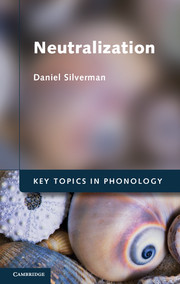Book contents
- Frontmatter
- Contents
- List of Figures
- Preface
- Acknowledgments
- 1 The rhyme and the reason of neutralization
- Part I Rhyme
- Section A Observation and description
- Section B False positives
- Section C Explanation
- Section D Exemplification
- 12 Case study
- 13 Domains of application
- 14 “Distinctions are drawn that matter”
- Part II Reason
- Glossary
- References
- Language index
- Subject index
14 - “Distinctions are drawn that matter”
Published online by Cambridge University Press: 05 November 2012
- Frontmatter
- Contents
- List of Figures
- Preface
- Acknowledgments
- 1 The rhyme and the reason of neutralization
- Part I Rhyme
- Section A Observation and description
- Section B False positives
- Section C Explanation
- Section D Exemplification
- 12 Case study
- 13 Domains of application
- 14 “Distinctions are drawn that matter”
- Part II Reason
- Glossary
- References
- Language index
- Subject index
Summary
In Chapter 12 we explored in detail a single case study, testing the overarching proposal advanced herein: a language is more likely to tolerate neutralizing alternations if the product of these processes does not unduly increase semantic ambiguity in the speech signal, in the form of deriving excessive homophony, excessive neutralization. In Chapter 13, we considered the domains over which an anti-homophonic pressure on language change might exert its force. In this final chapter of Part I, rhyme, we focus on the potential functional consequences of speech variation itself. We consider several unusual cases of alternation that reinforce the proposal that variation in speech – even phonetically unnatural variation – may naturally evolve in a language, provided the phonetic distinctions have immaterial consequences for semantic distinctions.
Instead, as we'll see, “distinctions are drawn that matter”; we'll unpack this somewhat opaque Wittgenstein-esque aphorism by exploring three cases in detail. We first we consider a peculiar case of phonetic variation that was purportedly present in the history of Austronesian (Blevins 2004). We move on to consider the s-to-h change in Eastern Andalusian Spanish (Gerfen 2001). Finally, we discuss a very perplexing pattern of genuinely neutralizing variation in Pirahã (Everett 2008).
- Type
- Chapter
- Information
- Neutralization , pp. 149 - 158Publisher: Cambridge University PressPrint publication year: 2012

